 Chapter 2: Management Approaches to Support Participation in your Team
Chapter 2: Management Approaches to Support Participation in your Team
It goes without saying that management support is crucial in order to create a culture of true participation. One sole practitioner being an expert in participation may be fantastic for a particular group of young people, and certainly make the practitioner popular, but it can seem futile if that good practice is not supported, disseminated or celebrated.
It is incumbent upon managers (with support from the executive above) to understand where their practitioners are in terms of participation, why this might be, where you might want them to get to, and how to foster a really child-centred approach.
This means recognising the barriers to participation as well as the existing successes.
‘It often feels like adults have much more important things to be doing than listening to kids’
‘Being able to get support for problems and questions really help’
Where would you place your team’s current level of participation in the categories below? Why is it at that level? Where would you like it to be?
Adapted from Roger Hart’s Ladder of Participation and Phil Treseder – Empowering Children and Young People (1997)
Adult-initiated, shared decisions with children
Adults have the initial idea, but young people are involved in every step of the planning and implementation, including taking decisions.
Child-initiated, shared decisions with adults
Children have the ideas and set up the project. Adults do not direct but share their expertise, advise and support the young people.
Child-initiated and directed
Young people have the idea, decide how the project will work and make all of the ultimate decisions (adults are available but do not take charge).
Assigned but informed
Adults decide on the project and children volunteer for it. They understand the project, know why they’re involved and that adults respect their views.
Consulted and informed
Adults design and run the project but consult young people. They understand the project and that their input is taken seriously.
Manipulation
It may appear that young people are involved but projects are adult led and any involvement from young people is not really understood by the young people themselves.
Decoration
Adults lead the project but then put a young person ‘on display’ to push the cause. The young person may not understand the project at all.
Tokenism
Children are seen to be given a voice, but have little choice over the subject, style of project or what happens as a result of it.
For any practice to progress, you must first understand why it may not have done up to this point. It is rare that any professional would under-value the impact participation can have, but it may be overwhelming for a variety of reasons. Below are some potential challenges, as outlined by practitioners themselves.
Logistics
Where do we do it?
Is there funding? How about transport?
How to approach it
Where do I start?
Who am I asking and why?
Will anyone come/participate?
Have they already been asked these questions?
Lack of resources
What about rewards and refreshments?
Do we have enough time for this activity?
Is there enough staff?
How do I make it dynamic?
Knowledge
What makes good participation?
What kinds of activities could I use?
How will I record and evaluate it?
Expectations
How will the findings be used?
Is it worthwhile, or a tick-box exercise?
What do I do with the information?
Does this come within role?
Safeguarding concerns
What if a safeguarding issue emerges?
How do I risk-assess?
What data can I collect and how do I store it?
Managers may have to consider extra elements, such as staff capacity, ease of analysis, credibility for funders and validity with stakeholders.
These are all very understandable concerns, so the role of a manager is to myth-bust and support in a variety of ways.
Often, the elephant in the room will be ‘time’. If professionals are over-burdened and ‘fire-fighting’, taking the time to listen to the views of children and young people and then acting on it, may be daunting. However, when participation is supported, prioritised, done in a meaningful way, and generates focused outcomes, it can result in ‘less fires’ to put out longer-term.
‘It often feels like adults have much more important things to be doing than listening to kids’

As well as being an excellent tool for engaging young people one-to-one on any topic, a coaching wheel is also incredibly effective in staff development when looking at barriers/challenges.
The premise is simple: outline six potential challenges around the edge of the wheel (in this case those identified by practitioners in terms of participation).
Individuals then shade the areas in response to a question posed. It is always better to emphasise positives so the question, in this case, would be ‘How confident are you in these areas of participation?’
This then has multiple uses:
‘Many of the professionals can’t do anything about my views because they are restricted, even if they do care’
‘When professionals get it right it makes a huge difference’
Using a checklist can help in planning but also give confidence in approaching participation.
Are the aims and objectives clear? Consider how they might be shared with young people.
Will the project/questionnaire/etc. impact on service? Consider how.
Does the project/ questionnaire/etc. have support from above? Consider what you might need from the organisation.
Does the project/questionnaire/ etc. have a set timescale? Consider how much you can realistically do in this.
Do you have your resources ready? Consider whether they are accessible and how you will record your findings.
Have you assigned the right staff to it? Consider if they will need any support.
Have you confirmed which young people you’re working with? Consider how inclusive the group is (or targeted if that’s the case).
Will they be rewarded for their time? Consider what is appropriate.
Have you supported access to participation? Consider transport and internet access needs (if applicable).
Do you have consent from the young people? Consider how you will get it if it is to be done on the day.
Are there any ground rules for the activity? Consider how they will be shared with young people.
Do you have permission to record/take photos? Consider how you will get it if it is to be done on the day.
Will there be confidential data or material collected? Consider how you will protect this and let young people know.
Are safeguarding issues likely to arise? Consider how you and your staff will implement policy on this.
Do you have a risk assessment in place? Consider how you will brief staff on this.
Have you considered how you might act on your findings? Tell young people there will be action, but manage expectations.
Have you considered how you will feedback to the young people involved (and beyond)? Let them know this.
Part of good management is attributing worth to your team; celebrating good practice and the next page highlights some ways of doing this. Another part, however, is supporting your staff in difficult situations. While professionals should always listen to and understand a child’s wishes, this has to be balanced against other considerations, like the resources available, or safety.
The scenario below is a good example of how ‘rubs’ and difficult situations are inevitable, even between professionals who all have a unique role to play. It doesn’t mean that anyone is doing their job badly, so long as all have the young person’s best interest at heart.

“I don’t want to wear a helmet. I don’t have to wear one. None of my friends wear one. Why do I have to wear a helmet just because I’m in care?” – Child
“I hear that you don’t want to wear a helmet. However, we need to keep you safe and so you should wear a helmet.” Wants the foster carer and advocate to encourage the young person to wear a helmet.” – Social Worker
“He says he doesn’t want to wear a helmet. I have discussed the safety issues with him, and he still doesn’t want to wear a helmet. Everyone should understand and respect his wishes.” – Advocate
“I am worried that you will get seriously hurt if you don’t wear a helmet. I ask all my children to wear a helmet. If you refuse to wear a helmet, then you can’t go out on your bike.” – Foster Carer
What can a manager to do help their team members faced with a difficult situation like this?
The more a team can recognise that there is as much value in holding your hands up and saying ‘this needs to be better, how do we support that?’ as there is in saying ‘this was amazing, let’s do more of it’, the more a culture shift will come. It is a combination of the two that is most effective.
HEAR ME is the advocacy service for children and young people in Herefordshire. They provide a professional, confidential and independent service for children and young people when they need support in representing their views with the local authority.
‘I was in a very dark space and the crisis team and NHS were able to keep me safe and supported constantly’

Some organisations already take time to celebrate staff going the extra mile with young people, using regular ‘Shout outs!’ Managers highlight great work and give a message of thanks.
The value of this kind of praise and affirmation cannot be underestimated, but there are limitations: it relies on managers submitting the ‘Shout outs’, and only staff get to see it. So, there’s no direct youth involvement.
Some counties take the approach of nominated groups/projects/individuals being awarded at a yearly ceremony.
As well as an awards evening (that could be organised by young people) there is also scope to have young people involved from the start. For example, an online form on a website could allow for anonymous nominations by young people (supported by a parent/guardian), a young person’s advocate or management. The reason for nomination could be chosen from a list of standards (a kitemark system) devised by young people.
Touches like this generate a principle of praise, therefore motivating staff, but also keep a real focus on aims and outcomes with young people in mind.
‘Staff are normally very patient, kind, understanding and will adapt to your needs and accommodate anything you need for the best experience’
‘Update your knowledge. There is so much new research and ideas about our systems, and many young people know these more updated ideas, so as professionals it’s important not to be stuck in the past’
As well as celebrating good practice within a team, there is also a need to share it. Putting Voice of the Child on the agenda (literally) sends a very clear message that it matters and that its role within service development is taken seriously.
For example, why not put ‘Participation Toolkit’ front and centre in your agenda:
WEEK ONE: Staff to look at digital copy of Toolkit and feed reflections back next week.
WEEK TWO: 5 mins feedback on reflections. Staff try an activity from the toolkit by next week.
WEEK THREE: 15 mins feedback on activities. Try one someone else did before next week.
WEEK FOUR: 15 mins feedback on how activities went…
CHALLENGE?
There can be a lot to get through in meetings, so finding the time to put participation on the agenda can be difficult. However, the benefits far outweigh the negatives.
BENEFITS:
What about putting young people at the centre of training? Who better to train professionals on how to work with young people than the young people themselves? The delivery is often fresher, the discussion more meaningful and, certainly, more powerful.
Continue to the next chapter: Chapter 3 – Strategic Planning and Service Improvement